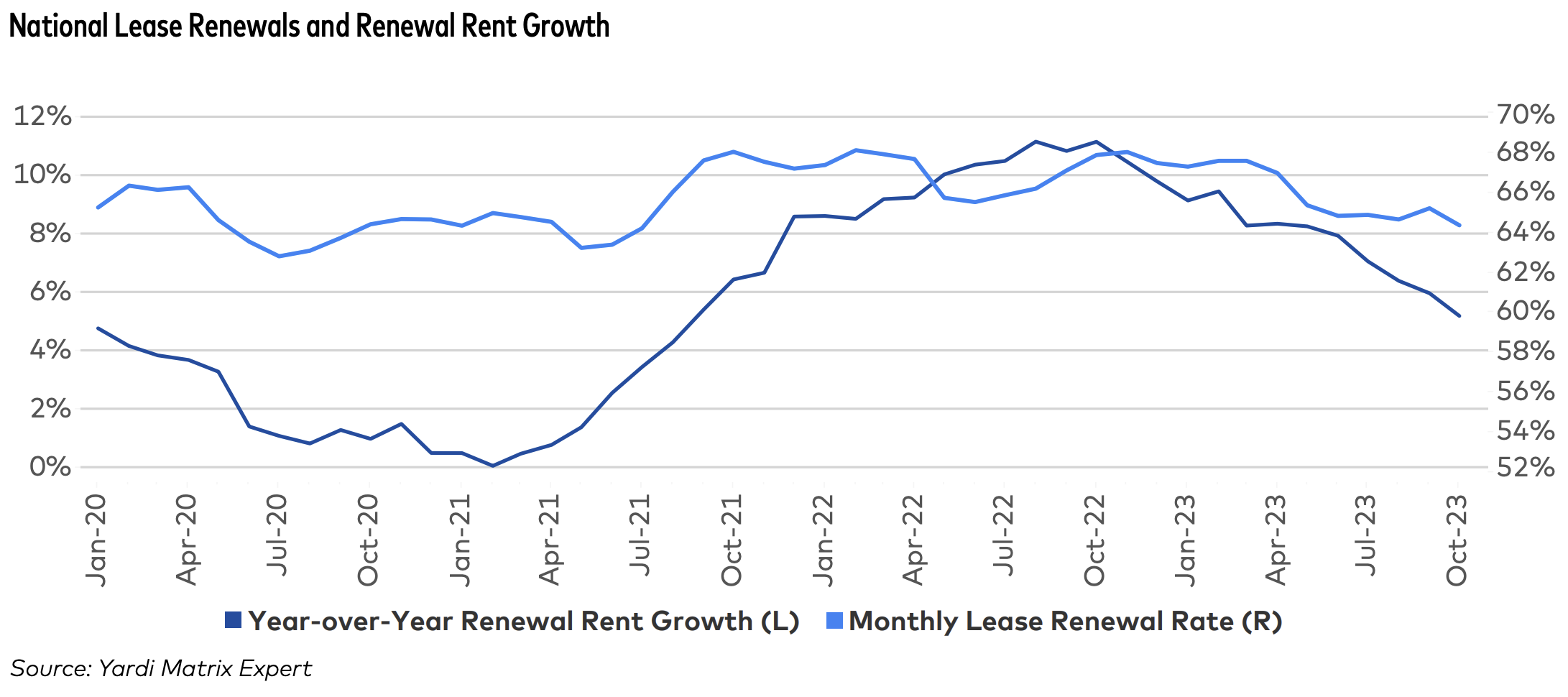The December 2023 National Multifamily Report by Yardi Matrix highlights the highs and lows of the multifamily market in 2023. Despite strong demand, the year-over-year (YOY) growth for rent remained largely unchanged at 0.3 percent—a stark contrast to December 2022's 6.4% YOY increase.
According to Yardi Matrix, 2023's full-year rent growth of 0.3% is the weakest rent performance since the 0.2% increase in 2010 (barring the 2020 pandemic year's 0.1% gain). Negative rent growth is affecting several major metropolitan areas as well, with Austin, Texas, ending the year at a -5.7% growth rate. Other metros such as Orlando, Fla.; Portland, Ore.; Phoenix, Ariz.; and Atlanta, Ga.; all are down by at least 3% year-over-year.

Strong job market
Despite the multifamily market ending 2023 on a downswing, conditions may not be as weak as they appear. A strong job market continues to drive demand and shows signs of holding up following the Federal Reserve's rate hikes.
Also aiding in demand is net immigration, which has increased by more than one million annually, according to the report.
Occupancy rates
The national occupancy rate left December 2023 at 94.8 percent, unchanged from the previous month. Rates were either unchanged or down YOY in all but five markets: Chicago, Ill. (+0.2% YOY), Seattle, Wash. (+0.2% YOY), Denver, Colo. (+0.1% YOY), Washington, D.C. (+0.1% YOY), and the Twin Cities (+0.1% YOY).
Atlanta had the largest decline of the year, down 1.3 percent.

Overall outlook for multifamily housing in 2024
- Expenses, income, deliveries, and interest rates pose key challenges for the multifamily industry this year
- Though the market is expected to deliver over 500,000 units this year, there is a dramatic decrease in starts
- Recent interest rate declines alleviate potential distress for multifamily owners, but long-term stability remains uncertain
Related Stories
Industry Research | Jun 15, 2023
Exurbs and emerging suburbs having fastest population growth, says Cushman & Wakefield
Recently released county and metro-level population growth data by the U.S. Census Bureau shows that the fastest growing areas are found in exurbs and emerging suburbs.
Engineers | Jun 14, 2023
The high cost of low maintenance
Walter P Moore’s Javier Balma, PhD, PE, SE, and Webb Wright, PE, identify the primary causes of engineering failures, define proactive versus reactive maintenance, recognize the reasons for deferred maintenance, and identify the financial and safety risks related to deferred maintenance.
Mixed-Use | Jun 12, 2023
Goettsch Partners completes its largest China project to date: a mixed-used, five-tower complex
Chicago-based global architecture firm Goettsch Partners (GP) recently announced the completion of its largest project in China to date: the China Resources Qianhai Center, a mixed-use complex in the Qianhai district of Shenzhen. Developed by CR Land, the project includes five towers totaling almost 472,000 square meters (4.6 million sf).
Mixed-Use | Jun 6, 2023
Public-private partnerships crucial to central business district revitalization
Central Business Districts are under pressure to keep themselves relevant as they face competition from new, vibrant mixed-use neighborhoods emerging across the world’s largest cities.
Multifamily Housing | Jun 6, 2023
Minnesota expected to adopt building code that would cut energy use by 80%
Minnesota Gov. Tim Walz is expected to soon sign a bill that would change the state’s commercial building code so that new structures would use 80% less energy when compared to a 2004 baseline standard. The legislation aims for full implementation of the new code by 2036.
Student Housing | Jun 5, 2023
The power of student engagement: How on-campus student housing can increase enrollment
Studies have confirmed that students are more likely to graduate when they live on campus, particularly when the on-campus experience encourages student learning and engagement, writes Design Collaborative's Nathan Woods, AIA.
Multifamily Housing | Jun 1, 2023
Income-based electric bills spark debate on whether they would harm or hurt EV and heat pump adoption
Starting in 2024, the electric bills of most Californians could be based not only on how much power they use, but also on how much money they make. Those who have higher incomes would pay more; those with lower incomes would see their electric bills decline - a concept known as income-based electric bills.
Multifamily Housing | May 30, 2023
Boston’s new stretch code requires new multifamily structures to meet Passive House building requirements
Phius certifications are expected to become more common as states and cities boost green building standards. The City of Boston recently adopted Massachusetts’s so-called opt-in building code, a set of sustainability standards that goes beyond the standard state code.
Multifamily Housing | May 30, 2023
Milhaus, Gershman Partners, and Citimark close on $70 million multifamily development in Indy
Versa will bring 233 studio and one- and two-bedroom apartments to Indianapolis's $271 million, Class-A Broad Ripple Village development enterprise.
Multifamily Housing | May 23, 2023
One out of three office buildings in largest U.S. cities are suitable for residential conversion
Roughly one in three office buildings in the largest U.S. cities are well suited to be converted to multifamily residential properties, according to a study by global real estate firm Avison Young. Some 6,206 buildings across 10 U.S. cities present viable opportunities for conversion to residential use.


















